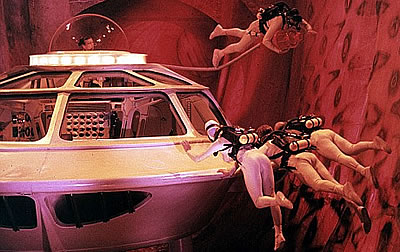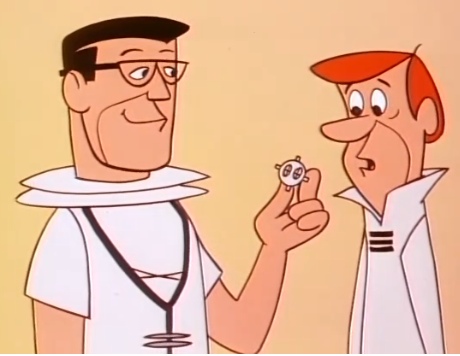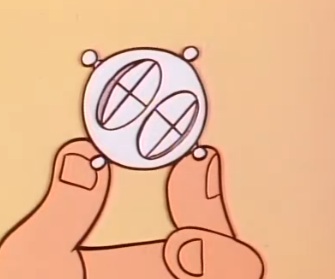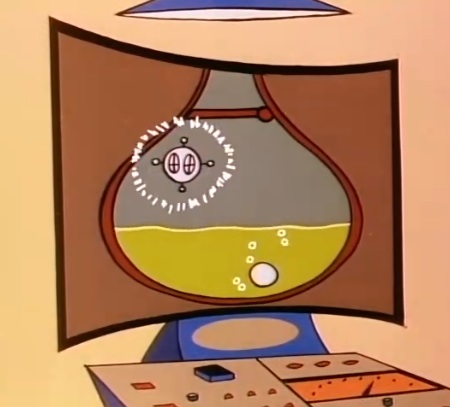Science Fiction
Dictionary
A B C D E F G H I J K L M N O P Q R S T U V W X Y Z
Watch A Man Swallow A Robot

It's not every day that you see a guy swallow a robot!
Of course, this is a "pillbot" an endoscopic camera that can be maneuvered remotely to look at whatever the doctor wants. This is a huge improvement over previous pill cameras, which just tumbled and clicked, and you took pot luck as far as what was pictured.
Science fiction fans may regard this ingestible device as being similar to the Proteus, the miniaturized ship from the 1966 movie Fantastic Voyage. Instead of having a miniaturized pilot on board, the pill camera is of course piloted remotely.

(Proteus from Fantastic Voyage)
Here's an early "science-fictional" view of this idea, that I saw on television when only a small child. In Test Pilot, an episode of The Jetson's first broadcast on December 30, 1962, George Jetson goes in for a physical. The doctor uses a special capsule called a "Peek-a-Boo Prober".

(Peek-a-Boo Prober from Jetson's Test Pilot episode)
Here's a close-up:

(Close-up of the Peek-a-Boo Prober from Jetson's Test Pilot episode)
The doctor uses a special Peek-a-Boo Prober launcher to start it on its journey through the patient. Once inside the doctor uses a voice-control interface to instruct the Prober. Take a look at an internal video provided by the Prober to the doctor.

(Peek-a-Boo Prober in stomach episode)
Scroll down for more stories in the same category. (Story submitted 7/7/2021)
Follow this kind of news @Technovelgy.| Email | RSS | Blog It | Stumble | del.icio.us | Digg | Reddit |
Would
you like to contribute a story tip?
It's easy:
Get the URL of the story, and the related sf author, and add
it here.
Comment/Join discussion ( 0 )
Related News Stories - (" Robotics ")
Artificial Skin For Robots Is Coming Right Along
'... an elastic, tinted material that had all the feel and appearance of human flesh and epidermis.' - Harl Vincent (1934)
Robot Guard Dog On Duty
I might also be thinking of K-9 from Doctor Who.
Wearable Artificial Fabric Muscles
'It is remarkable that the long leverages of their machines are in most cases actuated by a sort of sham musculature...' HG Wells, 1898.
Dancing Robots Taught Dance Moves
'A clockwork figure would be the thing for you...' Jerome K. Jerome, 1893.
Technovelgy (that's tech-novel-gee!) is devoted to the creative science inventions and ideas of sf authors. Look for the Invention Category that interests you, the Glossary, the Invention Timeline, or see what's New.
Science Fiction
Timeline
1600-1899
1900-1939
1940's 1950's
1960's 1970's
1980's 1990's
2000's 2010's
Current News
The Zapata Air Scooter Would Be Great In A Science Fiction Story
'Betty's slapdash style.'
Thermostabilized Wet Meat Product (NASA Prototype)
There are no orbiting Michelin stars. Yet.
Could Crystal Batteries Generate Power For Centuries?
'Power could be compressed thus into an inch-square cube of what looked like blue-white ice'
India Ponders Always-On Smartphone Location Tracking
'It is necessary... for your own protection.'
Amazon Will Send You Heinlein's Knockdown Cabin
'It's so light that you can set it up in five minutes by yourself...'
Is It Time To Forbid Human Driving?
'Heavy penalties... were to be applied to any one found driving manually-controlled machines.'
Replace The Smartphone With A Connected Edge Node For AI Inference
'Buy a Little Dingbat... electropen, wrist watch, pocketphone, pocket radio, billfold ... all in one.'
Artificial Skin For Robots Is Coming Right Along
'... an elastic, tinted material that had all the feel and appearance of human flesh and epidermis.'
Robot Guard Dog On Duty
I might also be thinking of K-9 from Doctor Who.
Wearable Artificial Fabric Muscles
'It is remarkable that the long leverages of their machines are in most cases actuated by a sort of sham musculature...'
BrainBridge Concept Transplant Of Human Head Proposed
'Briquet’s head seemed to think that to find and attach a new body to her head was as easy as to fit and sew a new dress.'
Google's Nano Banana Pro Presents Handwritten Math Solutions
'...copy was turned out in a charming and entirely feminine handwriting.'
Edible Meat-Like Fungus Like Barbara Hambly's Slunch?
'It was almost unheard of for slunch to spread that fast...'
Sunday Robotics 'Memo' Bot Has Unique Training Glove
'He then started hand movements of definite pattern...'
Woman Marries Computer, Vonnegut's Dream Comes True
'Men are made of protoplasm... Lasts forever.'
Natural Gait With Prosthetic Connected To Nervous System
'The leg was to function, in a way, as a servo-mechanism operated by Larry’s brain...'
